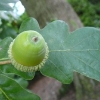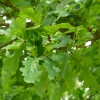Features
Leaves are mid to dark green, turning red/brown in autumn, and lobed in a stereotypically oak shape. Inconspicuous green/yellow catkin flowers appear in spring, followed by achene fruits (acorns) in autumn. Oaks can be identified by their typical clusters of buds at the tips of stems.
What to use it for
The oak turns into a large tree, so it would not be suitable for a small garden. In a wider landscape it can create a fabulous focal point, and the acorns provide food for wildlife.
It can be kept trimmed as a deciduous hedge. Otherwise it’s a very low maintenance plant.
How to look after it
Aside from a small amount of formative pruning, and the removal or any dangerous branches, very little maintenance is required for this oak.
How to prune it
Any pruning should be done when the tree is dormant; between autumn and early spring. Young trees should be trained as a standard with a single, central leader. By the third or fourth year of training, the trunk should be cleared of side shoots up to about ¼ of its overall height. Beyond this little formative pruning is required.
On mature trees, any dead, diseased or damaged branches should be removed by a specialist tree surgeon, particularly heavy branches where there is a risk of them falling.
Oaks can be pollarded to renovate them or keep them growing as a low hedge.
How to propagate it
The easiest method is to propagate by seed in mid to late autumn, or early spring. Collect fresh acorns, making sure that they are undamaged, particularly by small, round nut weevil holes. Sow them immediately in deep pots (such as root trainers) or seedbeds which are protected from rodents (eg by chicken wire). Alternatively (particularly if rodents are a problem) store the acorns over the winter in a refrigerator (put them in a sealed plastic bag with moist materials such as vermiculite) and sow them in early spring (check the acorns regularly and sow immediately any which start to sprout). Seedlings should be transplanted from pot to pot (or between beds) a couple of times before they are planted in their final location, to encourage a fibrous root system which will help the plant establish quickly.
Semi-ripe cuttings can be taken from early to mid autumn and rooted with bottom heat around 18-20°C.
Grafting is a more technical method of oak propagation, but can be useful for rarer oaks which don’t propagate as readily from other methods. A whip or spliced side graft should be used for deciduous oaks such as Quercus robur.
Common problems
Pests affecting the common oak include aphids, caterpillars, leaf-mining moths, oak gall wasps (such as the common spangle gall wasp), chafers, oak phylloxerids, nut weevils and knopper gall wasps.
Powdery mildew can affect this tree, as can viruses (forming yellowish streaks and patterns on the leaves), leaf spot, leaf curl, rust, cankers, butt rot, heart rot, pipe rot and oak wilt (currently only found in the USA).
Old oaks often have dead branches at the top of the crown (sometimes called its ’stag head’). This is not necessarily a sign of ill health or imminent death – when water supplies are scarce oaks choose to deprioritise their upper growth to extend their overall lifespan.
Die back of branches (often preceded by sudden growth of new shoots on the trunk and lower branches called ‘epicormic’ growth) can indicate the start of the tree’s death – however its decline can take as long as it took the tree to reach maturity, so by no means is an indication that the tree should be felled.
Other useful information ?
Ingesting the acorns can cause severe discomfort to humans and are also toxic to horses (if consumed in large quantities). Often pigs are brought into horse grazing areas in the autumn to clear the majority of acorns. However, the bark is used medicinally to control bleeding and inflammation (taken internally for problems such as dysentery and diarrhoea, and externally for conditions such as sore throat, minor injuries and ulcers), as well as in the tanning and dyeing industries.
Quercus robur has been granted the RHS Award of Garden Merit.
Oaks can live for over 1,000 years. Some sources suggest that Quercus Robur specimens can grow to over 40m tall. In contradiction to this longevity, oaks are surprisingly bad at reproducing naturally as they need to grow for around 50 years before they produce the first crop of acorns, and then the majority of them are eaten or rot rather than germinating. However, enough are buried by forgetful squirrels and survive to germinate and continue the species.
Oak is used for construction purposes and furniture in many countries, although it can take as long as 150 years before an oak is ready to be used.
In ancient times oak trees were dedicated to Thor, the God of thunder, and it was believed that they could never be struck by lightning. This is why acorn-shaped wooden knobs are often used on the end of light or blind cords; they are thought to protect the house.









